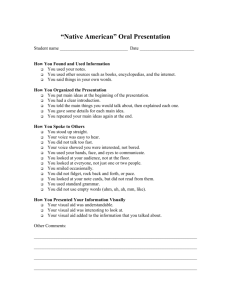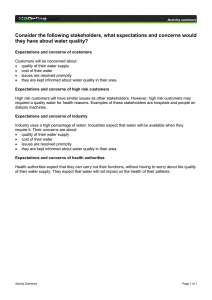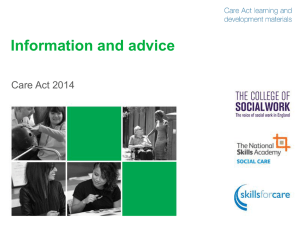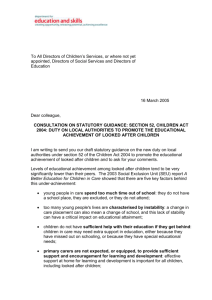Review of the Additional Support for Learning Act:
advertisement
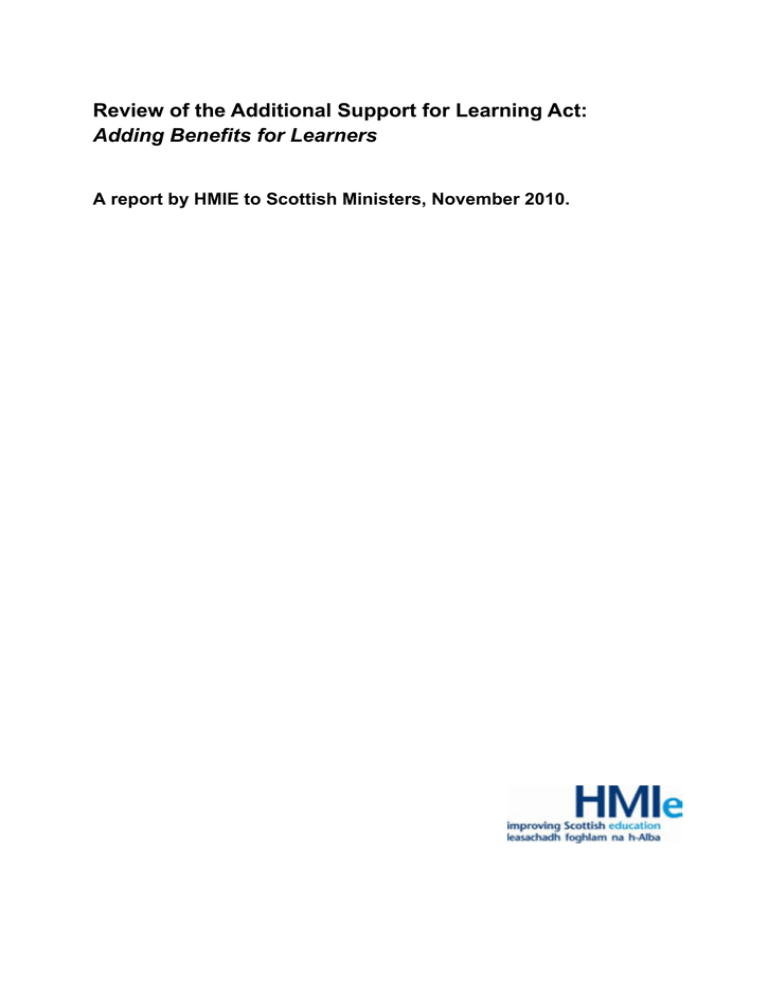
Review of the Additional Support for Learning Act: Adding Benefits for Learners A report by HMIE to Scottish Ministers, November 2010. Contents Page Background 1 Section 1: Recognising needs 3 Section 2: Addressing needs 4 Section 3: Securing the benefits 8 Section 4: Conclusion and recommendations 11 Background In May 2009, the Minister for Children and Early Years, gave a commitment to Parliament to establish a working group to report on how the Education (Additional Support for Learning) (Scotland) Act 2004 (the Act) is affecting children and young people who: are looked after; are young carers; have mental health disorders1; and have sensory impairments. HM Inspectorate of Education (HMIE) was asked to lead the review. In carrying out this task, HMIE set up a working group with colleagues from the Scottish Government, voluntary organisations and education authorities. We drew upon evidence from across the range of our work including: Improving Scottish Education 2005-2008 (HMIE 2009) Report on the Implementation of the Education (Additional Support for Learning) (Scotland) Act 2004 (HMIE 2007); inspections of pre-school, primary, secondary and special schools in the period 2006 to 2010; engagement with educational authorities in the period from November 2009 to May 2010; reviews of psychological services from March 2006 until March 2010; and aspect reports in the area of inclusion and additional support needs including reports on: education for deaf children; looked after children; and good practice in supporting young carers We also surveyed all education authorities about aspects of additional support needs including arrangements to meet the needs of the identified groups. Inspectors visited a sample of 15 education authorities and 48 schools. We gathered the views of stakeholders, parents, carers and young people on the quality of provision for additional support needs. A group of young people attended a meeting of the working group to share their views. The Act became law in 2005. The Act provides the legal framework which underpins the system for identifying and addressing the additional support needs of children and young people who face barriers to learning. The Act aims to ensure that all children and young people are provided with the necessary support to help them work towards achieving their full potential. It also promotes collaborative working among all those supporting children and young people and sets out parents’ rights within the system. 1 This report will use the term ‘mental health issues’ rather than ‘mental health disorders’ because the latter term may be viewed as referring only to those with medically diagnosed mental health conditions. However, children and young people may not have mental health disorders as such but may still be facing significant challenges or issues with their mental health and it is important that the Act addresses the needs of this wider group. 1 The Act has been amended by the Education (Additional Support for Learning) (Scotland) Act 2009 (the 2009 Act). The 2009 Act will commence on 14 November 2010 and will strengthen the original 2004 Act. In particular, the Act, as amended, automatically deems that all looked after children and young people have additional support needs, unless the education authority determine that they do not require additional support in order to benefit from school education. Also, authorities must consider whether each looked after child or young person for whose school education they are responsible requires a coordinated support plan2 (CSP). In 2007, HMIE reported on how well authorities and schools were implementing the Act. Key findings showed that: inter-agency work had led to appropriate individualised educational programme (IEP) targets for children and young people with a range of communication and language difficulties; authorities were beginning to improve support for meeting the needs of looked after and accommodated children and young people; and a few authorities had established clear procedures for supporting looked after and accommodated children and young people in schools. However: in almost all authorities there was scope for further development of integrated approaches to assessment and intervention by care and education staff, particularly in supporting the needs of looked after children and young people; and provision for young people with mental health issues and young carers was at a relatively early stage of development. This report updates aspects of the HMIE report above and considers how the Act is working now for children and young people with additional support needs relating to being looked after; being a young carer; having mental health disorders and having sensory impairments. It also makes recommendations aimed at securing better learning outcomes for these children and young people. 2 Supporting Children’s Learning Code of Practice (revised edition) (Scottish Government 2010) http://www.scotland.gov.uk/Publications/2010/08/11140218/0 2 Section 1: Recognising needs There are positive signs that the Act, sitting alongside the national policies of Curriculum for Excellence and Getting It Right for Every Child (GIRFEC), is contributing to staff in schools, and staff in partner agencies, having an increased sense of shared responsibility for identifying and addressing learning needs. Over the past three years, evidence from inspections across pre-5, primary and secondary schools shows that most establishments have effective approaches for identifying children’s additional support needs. These approaches are underpinned by staged intervention processes, as set out by education authorities. Almost all education authorities are applying appropriate strategies and have provided establishments with useful guidance to help ensure that children and young people have access to the support they need. Authority-wide resources, such as psychological services and specialist support teams, play a major role in the identification of needs and in planning how best to support individuals. Most authorities have built effectively on established multi-agency working to provide improved assessment and advice on the most appropriate level and types of support that a child or young person requires. Authorities and schools are increasingly adopting the GIRFEC approach and recognise the strong interface between GIRFEC and staged intervention (see appendix 3). In areas where the GIRFEC approach is well established, staff in education and in other agencies report that it has had a positive impact on joint working. Specialist professionals, including audiologists, speech and language therapists, other health professionals and teachers of the deaf are involved in assessing the needs of children and young people with hearing impairments. Overall, across Scotland, education and health professionals work together effectively to identify and assess children’s needs before they enter pre-school services. Similarly, children with visual impairments benefit from early identification of their additional support needs. In schools and pre-5 establishments, staff are alert to children and young people’s sensory impairments and to ensuring that their ongoing needs are identified and that suitable support is provided. There is, however, considerable scope to have more effective approaches to identifying the more hidden needs of those who are looked after, young carers and those with mental health issues. This applies at both authority and establishment levels. Over the past ten years, there has been a range of guidance on how we can better support children and young people who are looked after (see appendix 4). The Scottish Government has recently set up the Looked After Strategic Implementation Group to promote better outcomes for children and young people, building on the outcomes of the National Residential Child Care Initiative3. The focus on improving 3 http://www.sircc.org.uk/nrcci 3 provision for these young people has brought about increased understanding of the ways in which schools and authorities can work with other professionals and service deliverers to bring about better outcomes for them. On the whole, authorities and schools have good arrangements in place to ensure that staff are aware of the children and young people who are looked after. However, weaknesses remain in identifying individual support needs, particularly when needs relate to emotional and mental wellbeing. The development of more effective approaches to identifying the additional support needs of children and young people with mental health issues is progressing slowly. Authorities and schools reported that the lack of clear working definitions for mental health issues is a major factor in holding back progress in this area. In the main, in cases where a child or young person has significant mental health issues with a medical diagnosis, specialist staff, such as those working in the Child and Adolescent Mental Health Service (CAMHS)4, work closely with school staff to identify and assess the individual’s needs. Effective practice in identifying the needs of young carers is also developing slowly. The key issue affecting progress is encouraging young people to share that they are providing care to another family member. Emerging good practice in promoting partnership working and a shared sense of responsibility to better meet the needs of young carers is being driven by the voluntary sector. Organisations, such as the Princess Royal Trust for Carers5, are working well with authorities and schools to raise awareness of the needs that young carers may have and how to identify those needs sensitively. Section 2: Addressing needs Planning The continuing strengthening of approaches to staged intervention and the early identification of needs, is bringing about improvements to the quality of educational experiences for children and young people with additional support needs. The Act has helped to reinforce the message that it is the responsibility of everyone working with a child to do their best, individually and collectively, to meet the needs of that child. Since the implementation of the Act, authorities and establishments have continued to embed multi-agency approaches to assist in the delivery of well-planned and appropriate support to individuals. Authorities have developed suitable planning arrangements to help ensure that individuals are receiving the right kind of support at the right time, and that it is impacting positively on their progress. Overall, authorities have developed their planning arrangements using the GIRFEC approach and in line with staged intervention processes. This is helping to provide more clarity for parents and staff about when a child requires extended support. 4 5 http://www.camh.org.uk/ http://www.carers.org/ 4 However, there are continuing issues about the range of non-statutory plans introduced by authorities and the need to ensure that plans take good account of desired short- and long-term outcomes for the child. This is particularly pertinent to looked after children and young people in residential care. Inspection evidence concurs with the findings of the recent Audit Scotland report, Getting it right for children in residential care (Audit Scotland 2010), that the majority of care plans for young people do not focus clearly enough on the outcomes intended for a child. The Act places a duty on authorities to provide a CSP for a child or young person with additional support needs arising from enduring, complex or multiple barriers to learning who needs significant additional support provided by the education authority and by one or more appropriate agencies6. Across Scotland, there remains considerable inconsistency and variability in the ways in which authorities are carrying out this duty and in the extent to which authorities and practitioners view CSPs as useful in planning and improving provision for learners. Responding to needs In 2007, the joint HMIE and The National Deaf Children’s Society (NDCS) publication, Count Us In: Achieving Success for Deaf Pupils, reported on the quality of provision for deaf children7 based on visits to a sample of establishments in 16 local authorities across Scotland. Overall, deaf pupils in mainstream schools, in specialist resources within mainstream schools, and in schools for the deaf, had a high level of support to meet their needs. However, due to the diversity of children and young people’s linguistic needs, it had become increasingly challenging to meet the needs of the individual. The report highlighted that making decisions about the most appropriate way to support language development for a deaf child is always difficult, and is often an emotive issue for parents. It commented on the fact that a number of services and individual schools had moved away from making such decisions at an early stage and had adopted a more flexible approach through regular reviews of children’s linguistic needs. Over the past three years, inspection evidence shows that establishments providing education for children and young people with hearing impairments are meeting individual learning needs effectively. In some cases, children’s needs are being met very effectively. Successful practice reflects the duty of the Act to involve the child, parent and other agencies in making decisions about how best to meet needs. Establishments are consistently using a team approach to plan how best to deliver support and to review the impact of the support on children’s progress. Teams of professionals, including teachers, educational psychologists, speech and language therapists and educational audiologists, come together regularly with parents to agree learning targets for individuals and agree how they will use their professional skills to promote the child’s progress. Overall, the needs of children and young people with visual impairments are being 6 These appropriate agencies are: any other local authority, any NHS Board, Skills Development Scotland, further education colleges, higher education institutions and the Scottish Agricultural College. 7 The term ‘deaf is used to refer to all children experiencing hearing loss, including temporary deafness. 5 addressed and met effectively in both specialist provisions and in mainstream schools. There is a sound understanding of the importance of professionals working together to share their expertise in order to provide appropriate support that enables children to maximise their progress. In particular, there is strong partnership working across health and education to facilitate children’s access to the curriculum and to address barriers to learning. This includes identifying suitable technologies and adapting materials to help children participate fully and successfully in a broad range of learning experiences. Across primary, secondary and special schools, we found that children and young people with visual impairments are making good progress in their learning. The Act introduced the concept of ‘additional support needs’ and its application to any child or young person who, for whatever reason, needs additional help with learning. Staff across education, and in partner agencies, are now more aware that factors relating to social, emotional, cognitive, linguistic, disability, or family and care circumstances, can cause barriers to learning. However, weaknesses in approaches to ensuring that staff know what potential barriers exist for individuals, lead to weaknesses in meeting the needs of some children. Children and young people may have several barriers to learning and their additional support needs can be complex. The Report on the Implementation of the Education (Additional Support for Learning) (Scotland) Act 2004 (HMIE 2007) noted that authorities were beginning to improve support for meeting the needs of children and young people who are looked after away from home. However, practice across authorities varied considerably. In 2008, the HMIE report, Count Us In: Improving the education of our looked after children found that, while good progress was being made in devising models for supporting looked after children, more needed to be done to improve the joint assessment of these needs so that support and resources can be targeted more effectively. Information and evidence gathered as part of this current review, shows that authorities demonstrate a strong commitment to improving outcomes for children and young people who are looked after away from home. A few, ahead of the 2009 Act, have deemed that all looked after children and young people have additional support needs. Most have emphasised the need for establishments to have a designated member of staff in a coordinating role to help ensure that children are being well supported and making progress. In examples of best practice, consistent with the GIRFEC approach, a child or young person who is looked after will have a member of staff who plays a key role in supporting them and in linking with those from other agencies involved in providing support. Partnership working across education, social work services, health, police and health continues to improve. This is helping to promote more effective planning and assessment of children’s ongoing and changing needs. It is also helping to ensure that children’s needs are being addressed more holistically. In a number of authorities, there are positive signs that exclusion rates for looked after children are reducing. A few authorities have been successful in raising attendance. Evidence from inspections of residential special schools since the Act came into force in November 2005, shows that most have effective approaches for addressing children’s learning needs. 6 However, in both mainstream and residential special schools, there is still much work to be done to ensure that barriers to learning are removed or minimised, as far as possible, and that children are engaged in relevant, enjoyable and stimulating learning experiences. Staff in establishments are not always sufficiently alert to the multiple barriers to learning that children who are looked after, either away from home or at home, may be experiencing. A child who is looked after may have a sensory impairment or be a young carer. Looked after children are four times more likely to experience mental health problems than their peers. Levels of achievement for children and young people who are looked after continue to be significantly below that of their peers. Those in leadership positions, at authority and establishment level, need to implement more effectively corporate parenting strategies and continue to promote positive attitudes and high expectations for this group. An area for improvement highlighted in the Report on the Implementation of the Education (Additional Support for Learning) (Scotland) Act 2004 (HMIE 2007) was provision for children and young people with mental health issues. Overall, little progress has been made in this area. There are still important weaknesses in recognising the range of mental and emotional barriers that may impact on children and young people’s learning and how best to address their needs. Across the education system, the ongoing focus on the promotion of health and wellbeing is helping staff to be more aware of the links between physical and mental health, and the impact of mental wellbeing on achievement. In Curriculum for Excellence, the statements of experiences and outcomes in health and wellbeing reflect a holistic approach to promoting the health and wellbeing of all children and young people. They build on the legislative requirements of the Schools (Health Promotion and Nutrition) (Scotland) Act 2007 and on Being Well, Doing Well (Scottish Health Promoting Schools Unit 2004). Generally, staff in schools and pre-5 centres are alert to children and young people’s emotional, physical and social needs and promote mental wellbeing through the school’s ethos and positive relationships. Increasingly, children and young people have access to support through groups set up to help with specific issues such as self-esteem, anger management and coping with change. Teachers, support assistants, home link workers and educational psychologists often work together to deliver these groups. These groups are usually for a specific purpose and for a fixed period of time. Children benefit from this support in the short term but schools and centres do not yet have in place effective approaches for assessing the mental and emotional needs of children in a systematic and progressive way. Overall, staff are not sufficiently aware of how other barriers to learning can impact on children’s mental health, for example, autism spectrum disorders, attention deficit hyperactivity disorder, long term medical conditions and being looked after. Across mainstream and special schools, the needs of children and young people with significant mental health issues are not always being met effectively. There are clear signs of improved partnership working between education and health services but this does not always result in the necessary types of support being provided for young people. Multi-agency planning and integrated assessments are becoming better established. When available, CAMHS play a very important part in meeting children’s needs. 7 CAMHS practitioners provide direct support to children and young people and also advise teachers on appropriate interventions and approaches to learning. However, across Scotland, schools and authorities report that there is limited access to CAMHS provision. Work is currently underway to establish standards for the effective delivery of CAMHS provision. Schools are increasingly working with partner and voluntary agencies to support the mental and emotional needs of children and families. Support is being provided both in schools and the community, for example through school-based counsellors, home-link workers and youth workers. While some children and young people with significant mental health issues are being well supported and their needs met effectively, this is not happening consistently across schools and authorities. Some of the most vulnerable children and young people are placed in residential schools or secure care services. Evidence over the past four years, shows that there are improvements in addressing the educational, social, emotional and behavioural needs of young people. In particular, independent residential special schools are increasingly providing a range of therapeutic support to help address young people’s mental health issues. Addressing the needs of young carers is a continuing challenge for authorities and schools. They do not always know who the young carers are. Overall, there is a lack of awareness of their needs and the impact of their responsibilities and family commitments. Authorities and schools need to be much more proactive in identifying who young carers are and in taking action to make things better for them. Support for this group of children and young people comes mainly through voluntary agencies. There are examples of very good partnership working between schools and the Princess Royal Trust for Carers to help address children’s needs. Action for Children8 also has a number of Young Carers Projects that supports liaison with local schools and individual support for children and young people. Section 3: Securing the benefits Managing information In order to ensure that children and young people are benefiting from the support provided, schools and authorities should have effective approaches to collecting, analysing and using relevant information. The information and data collected should be used to monitor children’s achievements and to target support and resources accordingly. All authorities are using staged intervention approaches that include the process of reviewing the effectiveness of the support provided for individuals and using that information to identify what should happen next. Overall, this is helping to ensure that the progress of children and young people with identified additional support needs is being tracked appropriately at both authority and establishment level. 8 http://www.actionforchildren.org.uk/ 8 However, due to the weaknesses in identifying the needs of those who are looked after, young carers and those with mental health issues, some children and young people are not receiving the help they need when they need it and continue to achieve well below their peers. The Scottish Government collects information each year on the numbers of children and young people with additional support needs through the Pupil Census. Until 2009, the Pupil Census collected data on children and young people with additional support needs who each had an individualised educational programme and/or a coordinated support plan. Returns for 2009 showed 44,177 children and young people as having additional support needs. In gathering information for this report, HMIE asked each authority to provide the number of children and young people with additional support needs in their authority. All 32 authorities responded. Six authorities did not provide this information. The other 26 authorities identified a total of 77,111 children and young people with additional support needs. This suggests that authorities are identifying almost twice as many children with additional support needs as those recorded through the Pupil Census. This is likely to be because authorities gave us data on all children or young people with additional support needs irrespective of whether they had IEPs and/or CSPs. The Pupil Census data collected in 2010, and due to be published in December 2010, will provide data on all children and young people with additional support needs whether or not they each had an IEPs and/or CSPs. Scottish Government, in partnership with education authorities, and in line with the Act 2009, has redesigned the pupil census to incorporate an extended range of factors giving rise to additional support needs. HMIE found that education authorities are not always fully aware of the range of additional support needs among children and young people in schools. When asked to provide the numbers of children and young people with additional support needs relating to the four specified groups, authorities supplied data for those with sensory impairments and those who are looked after away from home. However, information on children who are looked after at home, or in kinship care, is more difficult to obtain. Staff in schools are not always aware of children who are being looked after at home or in kinship care. Most authorities were unable to provide figures for the number of children and young people with mental health issues and for those who are young carers. The Scottish Government is currently reviewing aspects of data collection to improve information gathering on additional support needs. At present, the lack of clarity and consistency in collecting and collating appropriate data is hampering effective monitoring and interventions for the more vulnerable groups. Involving children and parents Children, young people and parents feel more involved in approaches to decision-making affecting them. Adherence to the Act, supported by the GIRFEC approach, is helping to ensure that children and young people have a better say in identifying their own needs and in planning for the types of support they receive. Education authorities reported that complaints linked to additional support needs remain at a low number. Overall, staff in schools deal successfully with issues 9 without the need for a complaint to be recorded. All authorities noted that the use of mediation, dispute resolution, or references to the Additional Support Needs Tribunal was rare. The Additional Support Needs Tribunal for Scotland9 provided its fifth Annual report in 2010. Since its inception in 2005, the Tribunal has received around 210 references. The Tribunal has not identified any references linked to looked after children or young carers. References regarding children and young people with autism spectrum disorder and social emotional and behavioural difficulties amounted to 36% of references in 2010. References relating to children and young people with visual impairment and hearing impairment amounted to 4% and 2% respectively. The NDCS carried out research on The Impact of the Education (Additional Support for Learning ) (Scotland) Act 2004 on Deaf Children. This work was based on a survey of NDCS members. The survey was sent to 256 members and 128 responded. The research considered specific aspects and reported overall that the majority of respondents were satisfied with the provision being made for their child. Around one-third raised some concerns about funding for equipment, levels of support in the classroom, availability of speech and language therapy and the British Sign Language skill levels of some of the staff working with children and young people. A majority of parents who responded to the survey did not have any disagreement with their school or authority. Very few parents had made use of formal mediation, dispute resolution or reference to the Tribunal. Corporate parenting Improving outcomes for children and young people who are looked after is a key Scottish Government priority. The publication of Extraordinary Lives (Social Work Inspection Agency 2006) and We Can and Must Do Better (Scottish Executive 2007)10 called for authorities to evaluate all of their services for looked after children against what good parents do. The message was reinforced in These Are Our Bairns (Scottish Government 2008) and Count Us In: Improving the education of looked after children (HMIE 2008). In implementing the Act, authorities have established better arrangements for identifying, addressing and reviewing the support needs of looked after children. They have put in place a range of posts with specific responsibilities for monitoring the progress of looked after children. In best practice, these posts involve monitoring children’s progress across education and care, and working with colleagues across the council area to bring about better outcomes for those children and young people who are looked after. Arrangements also include reports to education committees and council members on the progress being made by looked after children. Senior managers in schools have an awareness of corporate parenting. However, overall, staff in schools do not yet have a clear understanding of their corporate parenting responsibilities. Training and development Visiting specialist teachers and health professionals provide valuable training opportunities for staff in working in establishments with children and young people with sensory impairments. 9 10 www.asntscotland.gov.uk http://www.scotland.gov.uk/Publications/2007/01/15084446/0 10 Overall, staff in schools and pre-5 establishments do not feel confident in recognising and addressing the needs of children and young people with mental health issues. Those interviewed as part of the review, indicated that they would appreciate up-to-date training on issues such as self-harming, eating disorders and suicide prevention. They felt that opportunities for joint training with colleagues in health would be very beneficial. Recent legislation, regulation and guidance have helped to maintain a focus on improving outcomes for children and young people who are looked after. However, staff in schools are not always confident in addressing the range of needs that looked after children and young people may have. They are not sufficiently aware of relevant training materials, such as those issued to support We Can and Must Do Better, to assist them in meeting the needs of children and young people more effectively. Section 4: Conclusion and recommendations Conclusion The implementation of the Education (Additional Support for Learning) (Scotland) Act 2004 is playing an important part in helping to ensure that children and young people receive the help they need to be successful learners. Practitioners across services for children are more aware of many of the issues that can hinder learning and their individual and collective responsibilities for identifying and addressing them. Authorities have established staged intervention processes that are promoting and strengthening multi-agency working and better targeting of resources. Staged intervention, in conjunction with the GIRFEC practice model, is helping to ensure that children’s needs are being addressed more holistically. Importantly, it is also helping to secure a better say for children and parents in the decision-making processes. Children and young people with sensory impairments continue to have their additional support needs identified and addressed at an early stage through well established partnership working between health and education and through the implementation of early intervention strategies. The Act is contributing to the ongoing provision of timeous and appropriate support to children and young people with sensory impairments. A sensory impairment could be described as a more obvious additional support need. There are still improvements to be made in addressing the more hidden needs relating to being looked after, a young carer or having mental health issues. The perceived stigma associated with having mental health issues and the sensitivities around being a young carer, mean that these children and young people may not wish to be identified. While the Act has helped practitioners to be more aware of the range of factors that may act as barriers to learning, they need further training on how to identify and address them. The Act has served as one of a range of measures to promote more effective approaches to addressing the needs of children and young people who are looked after. Authorities and schools have continued to strengthen their arrangements for 11 supporting children and young people who are looked after away from home, including corporate parenting. However, there is considerable scope to improve approaches to supporting those who are looked after at home or in kinship care. There is also scope to improve the ways in which, at national and authority level, that information in relation to children and young people with additional support needs is collected and managed. To fulfil the aspiration of success for all learners, we need to know and understand the needs of individuals and to be assured that the support they are receiving is enabling them to achieve and achieve well. Recommendations The report has identified issues which should be addressed in order to achieve the best for children and young people who: are looked after; are young carers; have mental health disorders; or, have sensory impairments. Education authorities, partner agencies and establishments should improve approaches to identifying and addressing the needs of children and young people who are looked after, who are young carers and those with mental health issues. Education authorities should achieve better consistency in the provision of coordinated support plans for children and young people who meet the relevant criteria for having one, with particular consideration being given to children and young people who are looked after, are young carers, or have mental health disorders. Education authorities and NHS Boards should review availability and access to specialist support services for children and young people with mental health issues. Scottish Government and education authorities should ensure that relevant data and information are collected and managed effectively to help children receive, and benefit from, appropriate support. Education authorities, partner agencies and establishments should ensure that staff have appropriate training to help them meet the needs of children and young people with additional support needs. Education authorities and establishments should ensure that parents of children who are looked after, are young carers, or who have mental health issues are aware of their entitlements under the Act. These children and young people themselves should also be made aware of their entitlements under the Act. 12 Appendix 1 Membership of the task group Elisabeth Morrison, Who Cares? Scotland Louise Morgan, Princess Royal Trust for Young Carers Jan Savage, National Deaf Children’s Society Mary Dallas, Royal National Institute for the Blind Scotland Bryan Kirkcaldy, ADES, Head of Service, Fife Council The group also involved a number of parents and young people. In addition representatives from Scottish Government, from organisations including Princess Royal Trust, Children in Scotland and Respect Me made important contributions to the work of the group. Our thanks too to staff in the schools, education authorities and health boards visited in the course of the review. 13 Appendix 2: References HMIE Guide - Inclusion and Equality Part 1: Evaluating education and care placements for looked after children and young people (HMIE 2003) Extraordinary Lives (Social Work Inspection Agency 2006) Looked after children and young people: We can and must do better (Scottish Executive 2007) These are our bairns (Scottish Government 2008) Improving the Education of Looked After Children: A Guide for Local Authorities and Service Providers (Scottish Government 2009) Improving: Services for Children. How good is our corporate parenting? (HMIE 2009) Count Us In: Achieving Success for Deaf Pupils (HMIE and NDCS 2007) Count Us In: Missing Out (HMIE 2006) Getting it right for every child in Kinship and Foster Care - a National strategy (Scottish Government 2007) Count Us In: Improving the education of our looked after children (HMIE 2008) Core tasks for Designated Managers in educational and residential establishments in Scotland (Scottish Government 2008) Moving Forward in Kinship and Foster Care (Scottish Government 2009) The National Framework - Supporting learners from early years to positive, sustained destinations (Scottish Government and Learning and Teaching Scotland 2010) 14 Appendix 3 Meeting additional support needs11 GIRFEC Levels Level 1 Universal Level 2 Single agency plan Identifying Supporting Stage 1 Parents/pre-school staff/teachers/health or social services staff, other agencies identify child/young person needing support or planning which can be met within the existing pre-school or school setting. Internal support Single agency plan Support/planning put in place from within school resources but including monitoring and review of effectiveness by school and parents. A named individual from within the school coordinates the overall approach. An individualised educational programme (IEP) may be needed. Stage 2 Situation not resolved and need for further action identified. Advice and support sought from specialists outwith the school or centre but from within educational services. My World Triangle used as an assessment framework with specialist assessments provided as necessary. Stage 3 Situation not resolved and need for further action identified. Advice and support sought from specialists from agencies outwith education. Further multi-agency assessments using the My World Triangle used as an assessment framework. External support from within education Single agency plan Support/planning put in place using educational resources from outwith the school or centre including monitoring and review of effectiveness by multi-agency team as required, eg support from visiting teacher, educational psychologist etc. A named individual is responsible for coordinating the overall approach. IEP in place. External multi-agency support Multi-agency plan Support/planning put in place using support from health, social work services, voluntary agencies etc. as required. Arrangements put in place for monitoring and review, involving parents and all relevant professionals as required. A lead professional is responsible for co-ordinating the overall approach. Co-ordinated 11 support plan considered, as part of From Supporting Children’s Learning Code of Practice (Revised Edition) a single planning process. Scottish Government (2010) Level 3 Multiagency plan 15
